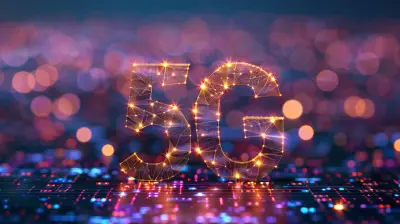The Growth of Biometric Security in Consumer Gadgets
22 November 2025
In today's digital world, security has never been more crucial. With cyber threats becoming increasingly sophisticated, traditional passwords just don’t cut it anymore. Enter biometric security—a game-changer in personal device protection. From fingerprint scanners to facial recognition, biometric authentication is taking over, making our gadgets more secure and user-friendly than ever.
But how did we get here? And where is this technology heading? Let's dive into the rise of biometric security in consumer gadgets, its advantages, and what the future holds for this cutting-edge innovation.

What Is Biometric Security?
Biometric security refers to using unique biological traits—like fingerprints, facial features, voice, or even iris patterns—to authenticate a user. Unlike passwords or PINs that can be forgotten or stolen, biometrics are inherently personal and nearly impossible to replicate.The implementation of biometrics has transformed the way we interact with our devices, offering a seamless yet highly secure experience. Whether it’s unlocking a smartphone, making mobile payments, or accessing sensitive apps, biometric authentication has become the go-to method for millions worldwide.

The Evolution of Biometric Security in Consumer Gadgets
Biometric technology has come a long way in a relatively short time. What once seemed like a futuristic concept straight out of a sci-fi movie is now a part of our daily lives. Let's take a look at its journey:Early Beginnings: Fingerprint Scanners
Remember when fingerprint scanners were a novelty? Apple’s Touch ID, introduced with the iPhone 5S in 2013, made biometric security mainstream. Before that, fingerprint recognition technology was mostly seen in high-security offices and government systems.Once Apple paved the way, other smartphone brands followed suit. Quickly, fingerprint sensors became a standard feature in phones, laptops, and even smart locks.
The Shift to Facial Recognition
Fingerprint scanners were just the beginning. In 2017, Apple revolutionized the biometric landscape again with Face ID on the iPhone X. Facial recognition technology took security up a notch, offering hands-free authentication. Rather than scanning your finger, your phone could now recognize your face—even in low-light conditions.Android manufacturers soon followed suit, integrating AI-powered facial recognition into their devices, enhancing security while keeping convenience in mind.
Beyond Fingerprints and Faces: The Rise of Voice and Iris Recognition
While fingerprints and facial recognition dominate, other forms of biometric security are gaining traction. Voice recognition allows users to unlock devices or perform actions using unique voice patterns. Meanwhile, iris scanning, which maps the intricate details of the human eye, adds an extra layer of protection in some high-end gadgets.Samsung's Iris Scanner, introduced in the Galaxy Note 7, proved that biometrics could go beyond just fingerprints and faces, although it didn't achieve widespread adoption due to convenience concerns.
Multi-Factor Biometric Authentication: The Future of Security
Why rely on just one form of authentication when you can combine multiple? Multi-factor biometric authentication merges fingerprint, facial, and voice recognition to bolster security while maintaining ease of access.For instance, some banking apps now use both facial and voice recognition for login approval, ensuring only the rightful owner gains access. This layered approach significantly reduces the risk of fraud and identity theft.

Why Biometric Security Is Becoming the Norm
With the increasing reliance on digital devices, security concerns have skyrocketed. Password leaks, phishing scams, and brute-force attacks have made traditional authentication methods unreliable. Biometric security solves these issues while offering additional benefits:1. Unmatched Convenience
Let’s be honest—nobody likes remembering complex passwords. With biometrics, you don’t have to! A simple fingerprint scan or face recognition unlocks your phone within seconds.2. Improved Security
Biometric data is unique to each individual, making it nearly impossible for hackers to replicate. Unlike passwords, which can be stolen or guessed, your fingerprints, face, or voice data are uniquely yours.3. Faster Transactions & Authentication
Mobile payment services like Apple Pay, Google Pay, and Samsung Pay leverage biometric authentication for seamless, secure transactions. With just a glance or a touch, you can approve purchases without hassle.4. Reduced Fraud and Identity Theft
Traditional authentication methods are vulnerable to cyberattacks. Hackers can steal passwords, but replicating biometric data is far more challenging. This makes biometric login systems significantly more secure.5. Hands-Free Authentication
With facial and voice recognition, users don’t even need to touch their devices. This has been especially beneficial during the pandemic when contactless interactions became the norm.
Biometric Security in Everyday Consumer Gadgets
Biometric security isn't just limited to smartphones anymore. It's now powering a variety of consumer gadgets, making everyday interactions safer and more convenient.1. Smartphones & Tablets
The most common use of biometrics is in our smartphones. Whether it’s Apple’s Face ID, Samsung’s Ultrasonic Fingerprint Scanner, or Google’s Face Unlock—smartphones have fully embraced biometric authentication.2. Laptops & PCs
Fingerprint readers are now built into many laptops, while Windows Hello enables facial recognition login. This eliminates the need for long, complex passwords while enhancing security.3. Wearable Tech
Smartwatches and fitness trackers are also incorporating biometric authentication. Apple's Touch ID-like sensor on the Apple Watch and Samsung’s Galaxy Watch with biometric protection show how wearables are stepping up their security game.4. Smart Home Devices & IoT
Home security has evolved with smart locks, video doorbells, and biometric safes. Devices like Nest Hello and Ring Video Doorbells now offer face recognition features, ensuring only familiar faces get access.5. Payment Systems
Contactless transactions have surged, thanks to biometric authentication! Services like Samsung Pay, Google Pay, and Apple Pay use biometric verification for secure and effortless payments.6. Automobiles
Some modern cars feature fingerprint ignition and facial recognition security systems. Tesla, for instance, uses biometric verification to personalize driver settings and improve security.Privacy Concerns & Challenges of Biometric Security
While biometric security offers exceptional protection, it’s not without concerns. Many critics argue that biometric data is sensitive—if compromised, it’s not as easily changed as a password. Let’s break down some of the main challenges:1. Data Privacy Issues
Your biometric data is stored either on your device or in cloud-based servers. If hackers breach these systems, your fingerprint or face data could be at risk. Companies must prioritize end-to-end encryption to keep this data secure.2. Potential for Biometric Spoofing
Although rare, biometric spoofing (using fake fingerprints, 3D face models, or recorded voices) poses a threat. However, new technologies like liveness detection and AI-powered anti-spoofing measures are addressing these vulnerabilities.3. Ethical Concerns
Many worry about how biometric data is used. Some governments and corporations collect facial recognition data for purposes beyond security—a growing ethical dilemma in the tech world.
What's Next for Biometric Security?
Biometric security will only get smarter and more sophisticated. Here’s a glimpse of what the future might hold:- DNA-based security: Imagine devices unlocking only when they detect your unique DNA sequence!
- AI-driven biometrics: Advanced AI algorithms could enhance security accuracy and further detect fraudulent attempts.
- Widespread multi-biometric authentication: Future devices may combine fingerprint, face, and voice recognition for rock-solid security.
- Neural authentication: Brainwave-based authentication could be the next frontier—recognizing users based on unique neural patterns.
Conclusion
Biometric security has undeniably transformed the way we interact with our gadgets. From fingerprint authentication to facial and voice recognition, this technology has made securing personal devices effortless yet highly effective.While privacy concerns linger, advancements in AI and encryption continue to strengthen biometric security. In the years to come, we can expect even more seamless, secure, and futuristic authentication methods to redefine digital security.
So, the next time you unlock your phone with a glance or a fingerprint, just remember—you’re witnessing the future of security in action!
all images in this post were generated using AI tools
Category:
Tech InnovationsAuthor:

Adeline Taylor
Discussion
rate this article
2 comments
Jennifer McAlister
In a world where identity could be a mere fingerprint away, the rise of biometric security whispers secrets of both convenience and peril. Are we securing our future or inviting new vulnerabilities?
December 2, 2025 at 12:29 PM

Adeline Taylor
Biometric security offers convenience and enhanced protection, but it also raises concerns about privacy and potential misuse. Striking a balance between security and vulnerability is crucial as we navigate this evolving landscape.
Isabelle Johnson
This article beautifully highlights the evolution of biometric security in consumer gadgets. It’s inspiring to see how technology is not only enhancing convenience but also prioritizing our safety. As we embrace these innovations, I’m excited to witness the positive impact on our daily lives. Thank you for sharing!
November 23, 2025 at 4:43 AM

Adeline Taylor
Thank you for your thoughtful comment! I'm glad you found the article inspiring and appreciate your insights on the impact of biometric security in our daily lives.


